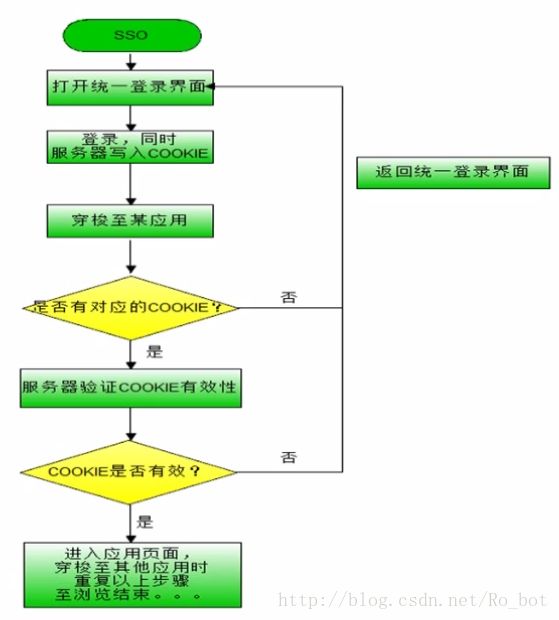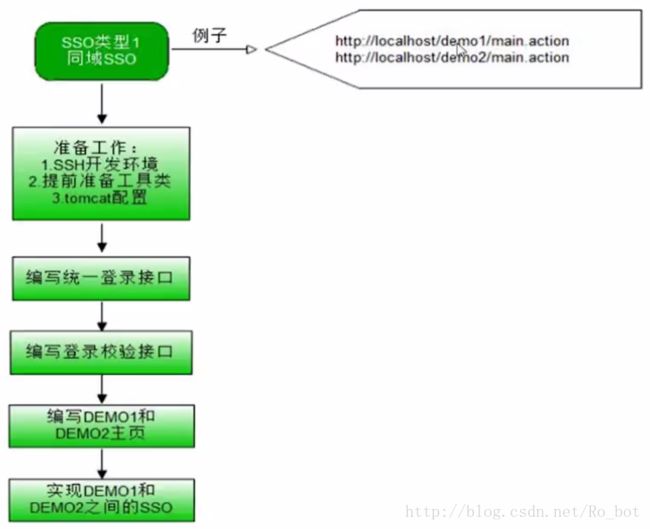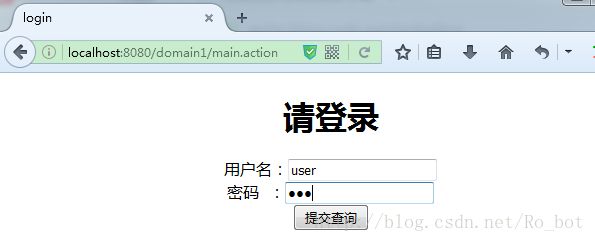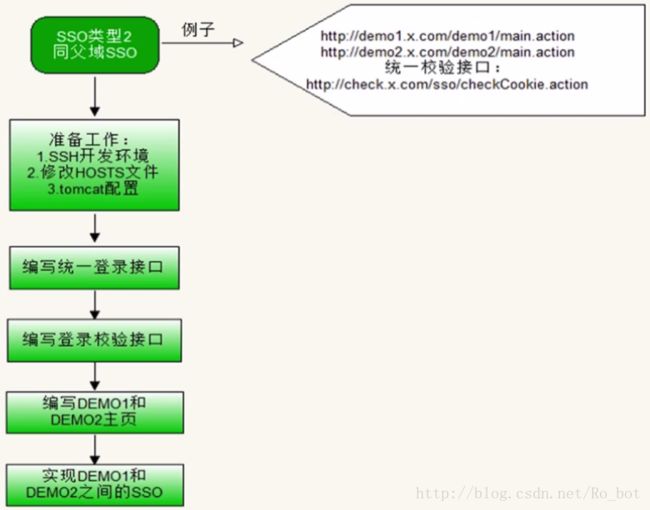SSO 单点登录
单点登录(Single Sign On),简称为 SSO,是目前比较流行的企业业务整合的解决方案之一。SSO的定义是在多个应用系统中,用户只需要登录一次就可以访问所有相互信任的应用系统。实现 SSO 的主要工具是 Cookie。
实现步骤
简的来说:申请票据、存储票据、查验票据。
同域 SSO 登录
此处使用 struts2 作为 MVC 框架,可根据实际需要替换
登录界面
接收用户登录信息
<%@ page contentType="text/html;charset=UTF-8" language="java"
pageEncoding="UTF-8" %>
<html>
<head>
<meta name="viewport" content="width=device-width, inital-scale=1">
<meta charset="UTF-8">
<title>logintitle>
head>
<body>
<center>
<h1>请登录h1>
<form action="/sso/doLogin.action" method="post">
<span>用户名:span><input type="text" name="username">
<span>密码 :span><input type="password"
name="password"><br>
<%-- gotoUrl 包含从其它页面过来的地址,登录完毕后跳转回 gotoUrl --%>
<input type="hidden" name="gotoUrl" value="${gotoUrl}">
<input type="submit">
form>
center>
body>
html>处理用户登录信息
import com.opensymphony.xwork2.ActionSupport;
import lee.sso.util.SSOCheck;
import org.apache.struts2.ServletActionContext;
import javax.servlet.http.Cookie;
import javax.servlet.http.HttpServletResponse;
public class SSOAction extends ActionSupport {
private String username;
private String password;
private String gotoUrl;
public String doLogin() {
/*
此处不进行数据用户数据验证,
只关注 sso
*/
boolean ok = SSOCheck.checkLogin(username, password);
if (ok) {
/*
此处 cookie 值应为加密后的值,此处亦省去
*/
Cookie cookie = new Cookie("ssocookie", "sso");
cookie.setPath("/");
HttpServletResponse response = ServletActionContext.getResponse();
response.addCookie(cookie);
return SUCCESS;
}
// 失败此处不做处理,或者返回登录页面
return null;
}
public String getUsername() {
return username;
}
public void setUsername(String username) {
this.username = username;
}
public String getPassword() {
return password;
}
public void setPassword(String password) {
this.password = password;
}
public String getGotoUrl() {
return gotoUrl;
}
public void setGotoUrl(String gotoUrl) {
this.gotoUrl = gotoUrl;
}
}处理登录信息工具类
import javax.servlet.http.Cookie;
import javax.servlet.http.HttpServletRequest;
public class SSOCheck {
public static final String USERNAME = "user";
public static final String PASSWORD = "123";
public static boolean checkLogin(String username, String password) {
return username.equals(USERNAME) && password.equals(PASSWORD) ? true
: false;
}
/**
* 实际开发时应放在拦截器,此处为了方便
*
* @param request
* @return
*/
public static boolean checkCookie(HttpServletRequest request) {
Cookie[] cookies = request.getCookies();
if (cookies != null && cookies.length > 0) {
for (Cookie cookie : cookies) {
if (cookie.getName().equals("ssocookie") && cookie.getValue()
.equals("sso"))
return true;
}
}
return false;
}
}登录页面的 struts2 配置
<package name="sso" namespace="/sso" extends="struts-default">
<action name="doLogin" class="lee.sso.action.SSOAction" method="doLogin">
<result name="success" type="redirect">${gotoUrl}result>
action>
package>编写 domain1
主页,当为用户访问时未登录将先跳转登录页面
<%@ page contentType="text/html;charset=UTF-8" language="java"
pageEncoding="UTF-8" %>
<html>
<head>
<meta name="viewport" content="width=device-width, inital-scale=1">
<meta charset="UTF-8">
<title>domain1 的标题title>
head>
<body>
<h1>欢迎访问 domain1,这是 domain1 的主页h1>
body>
html>domain1 Action 类
import com.opensymphony.xwork2.ActionSupport;
import lee.sso.util.SSOCheck;
import org.apache.struts2.ServletActionContext;
import javax.servlet.http.HttpServletRequest;
public class Domain1Action extends ActionSupport {
private String gotoUrl;
public String main() {
HttpServletRequest request = ServletActionContext.getRequest();
if (SSOCheck.checkCookie(request)) {
return SUCCESS;
}
// 此处声明登录完成后跳转的页面
gotoUrl = "/domain1/main.action";
return LOGIN;
}
public String getGotoUrl() {
return gotoUrl;
}
public void setGotoUrl(String gotoUrl) {
this.gotoUrl = gotoUrl;
}
}domain1 的 struts2 配置
name="domain1" namespace="/domain1"
extends="struts-default">
name="main" class="domain1.Domain1Action"
method="main">
<result name="success">/domain1.jspresult>
<result name="login">/login.jspresult>
domain2 与 domain1 区别不大,只需将 1 复制一份,将 1 改为 2 即可。
效果
填写 domain1 (别点提交)
进入 domain2 看看
domain1 点解提交
此时刷新 domain2 登录界面
神奇的一幕发生了,不需要登录信息直接进入 domain2 的主页
这是因为在登录 domain1 后服务器向我们发送了一个 cookie,浏览器保存了。当刷新 domain2 时,浏览器带着未过期的 cookie 给服务器发请求,服务器判断此 cookie 的会话是否还有效,若有,则直接跳过登录页面进入 domain2 主页。
同父域 SSO 登录
若在同一机器部署测试,可更改文件C:\Windows\System32\drivers\etc\hosts文件
由图可看出,同父域的 SSO 登录与同域 SSO 登录并无多大区别,需要解决的问题有两个,一个是 cookie 的跨域问题以及服务器之间的通信。可根据同域 SSO 登录修改代码。
cookie 跨域
此处主要使用了子域可访问父域cookie的机制。设置 cookie 时,需要我们统一一个 token ,即 cookie 的变量名。
我们访问http://demo1.x.com/demo1/main.action时,查看 request.getCookies()是否包含我们所需的信息,若无,则带着验证后跳转地址跳转到统一验证接口http://check.x.com/sso/doLogin.action验证用户名和密码。
统一验证接口返回 cookie 之前,必须设置
// 由 . 开头,则只有子域名可用。若无,则主域名和子域名可用
cookie.setDomain(".x.com"); // 同一父域名
cookie.setPath("/");浏览器保存cookie后,带着cookie跳转回
http://demo1.x.com/demo1/main.action
要设置setDomain(),否则请求无法携带cookie
服务器之间的通信
当http://demo1.x.com/demo1/main.action的服务器接收到cookie时,将cookie名和cookie值发给统一验证接口http://check.x.com/sso/checkCookie.action处理,约定好返回值是什么,成功返回后判断是否让其访问资源。
可通过 HttpURLConnection 类或者使用 HttpClient 客户端进行通信。
完全跨域 SSO 登录
即域名完全不同,如www.a.com和www.b.com
登录验证
进入www.a.com资源页面,查看cookie,若无,则跳转登录页面。
www.a.com服务器接收用户信息数据,但不验证,将用户信息数据传输http://www.x.com/sso/doLogin.action验证。
<form action="/doLogin.action">form>进入 action 类,根据代码逻辑与验证服务器通信
result = SSOUtil.post(checkSSOUrl, username, password);验证成功后返回信息给www.a.com,判断可访问资源后并向浏览器发送 cookie 存放确认用户身份的 token(即 cookieValue)
Cookie cookie = new Cookie(cookieName, cookieValue);
HttpServletResponse response = ServletActionContext.getResponse();
response.addCookie(cookie);分发 cookie
问题此cookie只有www.a.com才能访问,所以,需要在确定用户身份后,访问资源页面时向www.b.com发送请求,并让www.b.com向浏览器发送cookie的值
在www.a.com与www.b.com的action类里添加方法,传送兄弟 URL 和传参,则无论是访问 a 或 b ,登录成功后在cookie有效期内都能访问 b 或 a 的资源。
List urlList; // 存放兄弟 URL
String cookieName;
String cookieValue;
...
// Struts2 的 OGNL
setter/getter
...
public String main() {
...
urlList.add("www.b.com/demo2/pushCookieToBrowser.action"
+ "?cookieName=" + cookieName
+ "&cookieValue=" + cookieValue);
...
}
public void pushCookieToBrowser() {
HttpServletRequest request = ServletActionContext.getRequest();
this.cookieName = request.getParameter("cookieName");
this.cookieValue = request.getParameter("cookieValue");
Cookie cookie = new Cookie(cookieName, cookieValue);
HttpServletResponse response = ServletActionContext.getResponse();
response.addCookie(cookie);
} 在登录成功的资源页面使用









